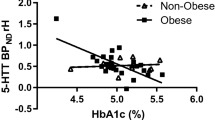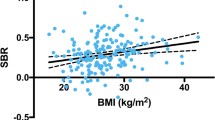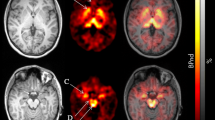Abstract
Serotonin transporter (SERT) is a presynaptically localized membrane protein that regulates the serotonin transmission via its reuptake of released serotonin. We hypothesized that glucose loading may change SERT availability from brainstem in humans. An intravenous bolus injection of 18F-FP-CIT was administered after the infusion of glucose or placebo (normal saline), and the emission data were acquired over 90 mins in 33 healthy nonobese subjects. For a volume-of-interest-based analysis, an atlas involving midbrain, and pons was applied. SERT availability, binding potential (BPND), were measured via the simplified reference tissue method with a reference of cerebellum. For a voxel-based analysis, statistical parametric mapping 12 was used with parametric BPND images. BPNDs from midbrain (p=0.8937), and pons (p=0.1115) were not different between glucose and placebo loading. Both of BPNDs from midbrain after glucose, and placebo loading were negatively correlated with body mass index (BMI). BMI showed a trend of negative correlation with glucose-loaded BPND from pons, whereas, placebo-loaded BPNDs from pons did not show any significant association with BMI. In conclusion, SERT availability was negatively correlated with BMI after glucose loading in humans. SERT might have a role in eating behavior through the action of insulin. Further studies are needed to elucidate the underlying mechanism of this phenomenon.




Similar content being viewed by others
Change history
25 April 2023
A Correction to this paper has been published: https://doi.org/10.1007/s11682-023-00779-1
References
Bellisle, F., Drewnowski, A., Anderson, G. H., Westerterp-Plantenga, M., & Martin, C. K. (2012). Sweetness, satiation, and satiety. J Nutr, 142(6), 1149S–1154S. https://doi.org/10.3945/jn.111.149583
Celada, P., Puig, M. V., & Artigas, F. (2013). Serotonin modulation of cortical neurons and networks. Front Integr Neurosci, 7, 25. https://doi.org/10.3389/fnint.2013.00025
Erritzoe, D., Frokjaer, V. G., Haahr, M. T., Kalbitzer, J., Svarer, C., Holst, K. K., et al. (2010). Cerebral serotonin transporter binding is inversely related to body mass index. Neuroimage, 52(1), 284–289. https://doi.org/10.1016/j.neuroimage.2010.03.086
Haahr, M. E., Hansen, D. L., Fisher, P. M., Svarer, C., Stenbaek, D. S., Madsen, K., et al. (2015). Central 5-HT neurotransmission modulates weight loss following gastric bypass surgery in obese individuals. J Neurosci, 35(14), 5884–5889. https://doi.org/10.1523/JNEUROSCI.3348-14.2015
Haltia, L. T., Rinne, J. O., Merisaari, H., Maguire, R. P., Savontaus, E., Helin, S., et al. (2007). Effects of intravenous glucose on dopaminergic function in the human brain in vivo. Synapse, 61(9), 748–756. https://doi.org/10.1002/syn.20418
Hesse, S., Rullmann, M., Luthardt, J., Winter, K., Hankir, M. K., Becker, G. A., et al. (2016). Central serotonin transporter availability in highly obese individuals compared with non-obese controls: A [(11)C] DASB positron emission tomography study. Eur J Nucl Med Mol Imaging, 43(6), 1096–1104. https://doi.org/10.1007/s00259-015-3243-y
Hesse, S., van de Giessen, E., Zientek, F., Petroff, D., Winter, K., Dickson, J. C., et al. (2014). Association of central serotonin transporter availability and body mass index in healthy Europeans. Eur Neuropsychopharmacol, 24(8), 1240–1247. https://doi.org/10.1016/j.euroneuro.2014.05.005
Koch, W., Unterrainer, M., Xiong, G., Bartenstein, P., Diemling, M., Varrone, A., et al. (2014). Extrastriatal binding of [(1)(2)(3)I]FP-CIT in the thalamus and pons: gender and age dependencies assessed in a European multicentre database of healthy controls. Eur J Nucl Med Mol Imaging, 41(10), 1938–1946. https://doi.org/10.1007/s00259-014-2785-8
Koskela, A. K., Kaurijoki, S., Pietilainen, K. H., Karhunen, L., Pesonen, U., Kuikka, J. T., et al. (2008). Serotonin transporter binding and acquired obesity -- an imaging study of monozygotic twin pairs. Physiol Behav, 93(4-5), 724–732. https://doi.org/10.1016/j.physbeh.2007.11.043
Lammertsma, A. A., & Hume, S. P. (1996). Simplified reference tissue model for PET receptor studies. Neuroimage, 4(3 Pt 1), 153–158. https://doi.org/10.1006/nimg.1996.0066
Leibowitz, S. F. (1988). Brain neurotransmitters and eating behavior in the elderly. Neurobiol Aging, 9(1), 20–22. https://doi.org/10.1016/s0197-4580(88)80007-1
Leibowitz, S. F., & Alexander, J. T. (1998). Hypothalamic serotonin in control of eating behavior, meal size, and body weight. Biol Psychiatry, 44(9), 851–864. https://doi.org/10.1016/s0006-3223(98)00186-3
Levin, B. E., & Routh, V. H. (1996). Role of the brain in energy balance and obesity. Am J Physiol, 271(3 Pt 2), R491–R500. https://doi.org/10.1152/ajpregu.1996.271.3.R491
Meneses, A., Perez-Garcia, G., Ponce-Lopez, T., Tellez, R., & Castillo, C. (2011). Serotonin transporter and memory. Neuropharmacology, 61(3), 355–363. https://doi.org/10.1016/j.neuropharm.2011.01.018
Michelson, D., Amsterdam, J. D., Quitkin, F. M., Reimherr, F. W., Rosenbaum, J. F., Zajecka, J., et al. (1999). Changes in weight during a 1-year trial of fluoxetine. Am J Psychiatry, 156(8), 1170–1176. https://doi.org/10.1176/ajp.156.8.1170
Morton, G. J., Meek, T. H., & Schwartz, M. W. (2014). Neurobiology of food intake in health and disease. Nat Rev Neurosci, 15(6), 367–378. https://doi.org/10.1038/nrn3745
Nam, S. B., Kim, K., Kim, B. S., Im, H. J., Lee, S. H., Kim, S. J., et al. (2018). The Effect of Obesity on the Availabilities of Dopamine and Serotonin Transporters. Sci Rep, 8(1), 4924. https://doi.org/10.1038/s41598-018-22814-8
Pak, K., Seo, S., Kim, K., Lee, M. J., Shin, M. J., Suh, S., et al. (2020). Striatal dopamine transporter changes after glucose loading in humans. Diabetes Obes Metab, 22(1), 116–122. https://doi.org/10.1111/dom.13872
Park, E., Hwang, Y. M., Chu, M. K., & Jung, K. Y. (2016). Increased Brainstem Serotonergic Transporter Availability in Adult Migraineurs: an [(18)F]FP-CIT PET Imaging Pilot Study. Nucl Med Mol Imaging, 50(1), 70–75. https://doi.org/10.1007/s13139-015-0373-x
Roselli, F., Pisciotta, N. M., Pennelli, M., Aniello, M. S., Gigante, A., De Caro, M. F., et al. (2010). Midbrain SERT in degenerative parkinsonisms: a 123I-FP-CIT SPECT study. Mov Disord, 25(12), 1853–1859. https://doi.org/10.1002/mds.23179
Rothman, R. B., Jayanthi, S., Wang, X., Dersch, C. M., Cadet, J. L., Prisinzano, T., et al. (2003). High-dose fenfluramine administration decreases serotonin transporter binding, but not serotonin transporter protein levels, in rat forebrain. Synapse, 50(3), 233–239. https://doi.org/10.1002/syn.10266
Takahashi, H., Nakashima, S., Ohama, E., Takeda, S., & Ikuta, F. (1986). Distribution of serotonin-containing cell bodies in the brainstem of the human fetus determined with immunohistochemistry using antiserotonin serum. Brain Dev, 8(4), 355-365. Retrieved from https://www.ncbi.nlm.nih.gov/pubmed/3541662
Versteeg, R. I., Koopman, K. E., Booij, J., Ackermans, M. T., Unmehopa, U. A., Fliers, E., et al. (2017). Serotonin Transporter Binding in the Diencephalon Is Reduced in Insulin-Resistant Obese Humans. Neuroendocrinology, 105(2), 141–149. https://doi.org/10.1159/000450549
Yen, T. T., & Fuller, R. W. (1992). Preclinical pharmacology of fluoxetine, a serotonergic drug for weight loss. Am J Clin Nutr, 55(1 Suppl), 177S–180S. https://doi.org/10.1093/ajcn/55.1.177s
Ethical approval
All procedures performed in studies involving human participants were in accordance with the ethical standards of the institutional and/or national research committee and the 1964 Helsinki Declaration and its later amendments or comparable ethical standards.
Consent to Participate
All participants signed an informed consent form prior to participation.
Consent to Publish
an informed consent was obtained.
Competing interests
The authors had no conflict of interest.
Availability of data and materials
The data that support the findings of this study are available from the corresponding author.
Funding
No
Author information
Authors and Affiliations
Contributions
Kyoungjune Pak: study design, write the manuscript, statistical analysis
Keunyoung Kim, Seongho Seo: study design
Myung Jun Lee, In Joo Kim: statistical analysis
Corresponding author
Additional information
Publisher’s note
Springer Nature remains neutral with regard to jurisdictional claims in published maps and institutional affiliations.
Supplementary Information
Below is the link to the electronic supplementary material.
Supplementary Figure 1. Comparison of BPNDs from midbrain, and pons after glucose, and placebo loading.
Rights and permissions
Springer Nature or its licensor (e.g. a society or other partner) holds exclusive rights to this article under a publishing agreement with the author(s) or other rightsholder(s); author self-archiving of the accepted manuscript version of this article is solely governed by the terms of such publishing agreement and applicable law.
About this article
Cite this article
Pak, K., Kim, K., Seo, S. et al. Serotonin transporter is negatively associated with body mass index after glucose loading in humans. Brain Imaging and Behavior 16, 1246–1251 (2022). https://doi.org/10.1007/s11682-021-00600-x
Accepted:
Published:
Issue Date:
DOI: https://doi.org/10.1007/s11682-021-00600-x




